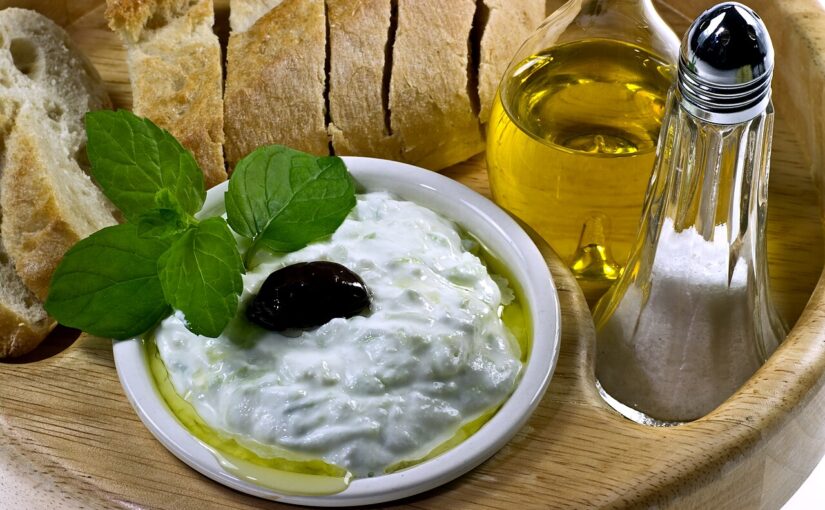Bright, tangy, and impossibly refreshing, tzatziki turns simple ingredients into a bowl of sunshine. Silky Greek yogurt hugs cool cucumber, zippy garlic, and lemon, creating the kind of dip that invites torn pieces of warm pita, crunchy veggies, and grilled meats to the table. It is the taste of long afternoons, sea breeze, and easy company. One spoonful and you get why people love it: it is light yet satisfying, simple yet luxurious, and perfect for sharing. 🌞🫓🥗
Ingredients 🌿
- 500 g full-fat Greek yogurt, strained if needed, about 2 cups
- 1 large cucumber, about 300 g, peeled or striped, seeds removed, grated 🥒
- 2 to 3 garlic cloves, finely grated or minced 🧄
- 2 tablespoons extra virgin olive oil 🫒
- 1 tablespoon fresh lemon juice 🍋
- 1 teaspoon white wine vinegar, optional for extra tang
- 2 tablespoons fresh dill, finely chopped 🌿
- 1 tablespoon fresh mint, finely chopped, optional
- 1 teaspoon fine sea salt, plus more to taste
- 1 to 2 pinches black pepper
- Garnish: olive oil, dill fronds, a sprinkle of sumac or paprika, a few olives
Yield and Time ⏱️
- Serves: 4 as a dip or side
- Prep time: 15 minutes
- Rest time: 30 to 60 minutes for best flavor
- Total: 45 to 75 minutes
Preparation 🥣
- Grate the cucumber, toss with a pinch of salt, then let it sit 10 minutes in a sieve.
- Squeeze out as much liquid as possible with clean hands or a towel until quite dry.
- In a bowl, combine yogurt, garlic, olive oil, lemon juice, vinegar, dill, mint, salt, and pepper.
- Fold in the dried cucumber. Taste and adjust salt, lemon, and garlic.
- Cover and chill 30 to 60 minutes to let the flavors bloom.
- Serve cold, drizzled with olive oil and topped with dill and a little sumac.
How to Serve Best 🍽️
- Scoop alongside warm pita or flatbread 🫓.
- Pair with grilled chicken, lamb, pork, fish, or halloumi.
- Dollop into gyros, souvlaki wraps, or grain bowls.
- Set out with cucumber, radishes, carrots, and cherry tomatoes for a crisp mezze.
- Store in the fridge up to 3 days, then stir before serving. Keep chilled at all times ❄️.
From Mountain Monasteries to Mezze Magic 🇬🇷
There is a quiet poetry to tzatziki. It echoes the old rhythms of the Eastern Mediterranean, where fresh dairy, garden herbs, and sturdy vegetables shaped daily life. In the countryside, shepherds prized strained yogurt for its keeping quality and nourishing richness. Cucumbers, grown in irrigated plots and courtyard gardens, offered coolness in the summer heat, while garlic and herbs brought boldness that traveled well from field to table. The technique is ancient and clever. Salting and squeezing the cucumber does more than reduce water. It concentrates flavor, a thrifty habit from a world that wasted nothing. The yogurt is not merely a base. It is an heirloom craft, once set in clay pots and thickened by time and patience, then whisked with olive oil, the treasured press of local groves. Tzatziki’s cousins are scattered across the Levant and the Balkans. You can taste family resemblance in cacık, tarator, and mast-o-khiar, each a regional love letter to yogurt and cucumber. Yet Greek tzatziki speaks with a distinct voice. Lemon brightens, dill lifts, olive oil rounds. It shines in the lively chaos of a mezze spread, where small plates invite long conversations and refilled glasses. Simple by design, tzatziki endures because it serves a feeling as much as a flavor. It is hospitality in a bowl, a cool pause between bites, a reminder that the best food often begins with what the garden and the day can spare.
Image: Nikodem Nijaki.
If our work has inspired you, helped you grow, or simply brought a little warmth to your day, consider supporting Thalysia.com with a small donation. Your contribution helps us continue exploring ancient landscapes, documenting local traditions, and celebrating the art of living well.
